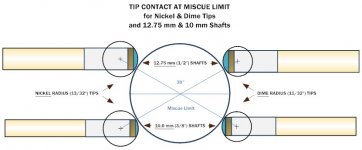Please forgive me if this question came up before.
I'm not talking about normal one to two tips outside of center English, I'm speaking of too much english, three tips maybe, when you put too much of Left English, or Right English, or even Draw real LOW english.
Which shape would help you not to miscue on this kind of shot, I've seen Earl Strickland talks about hitting shots , specially in his Exhibitions, as I'm sure most of you seen his crazy spins around the table, and around balls.
Earl Said that he likes his tip to be too rounded, if you look at it, you would see that the shape is almost like when you see a half a ball if you know what I mean, Too much Round, as if you cut a ball into half and put up on the cue.
My question is will this shape helps to generate more english, and will it also help the Tip to put a grab on the cueball which will lead to not Miscue?
I think about it with my common sense understanding of physic law, and it make sense to me, what do you think?
As long as the tip has some curvature; small tip 11.75, or 12mm helps, but most important is follow through, and loose grip, the longer the follow through the more spin, especially for long shots. Make sure you allow for cue deflection on fast shots, as well as swerve on low speed shots, watch cue elevation..

